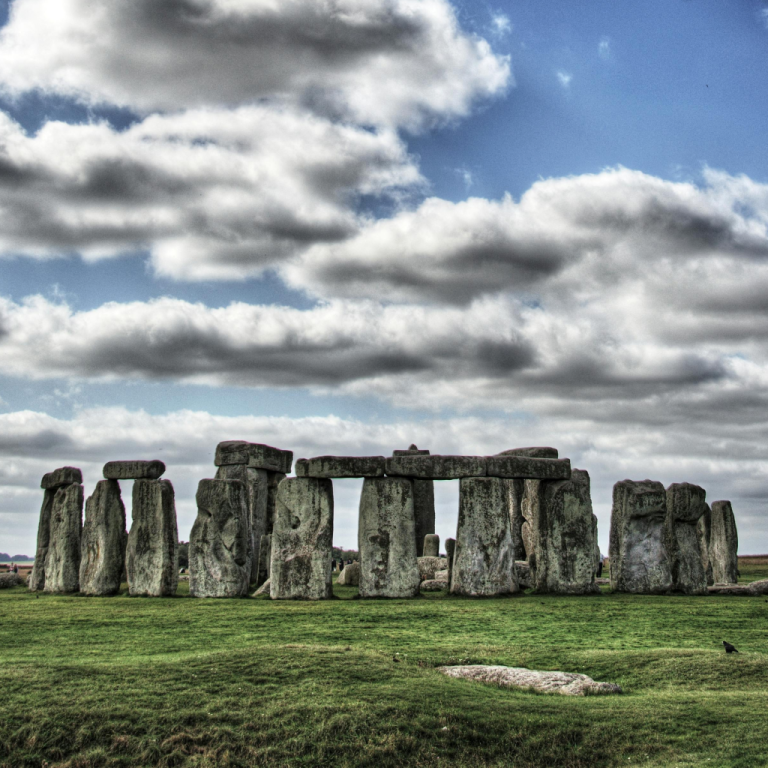Nestled in the rolling hills of Wiltshire, England, stands one of the world’s most enigmatic and awe-inspiring monuments: Stonehenge. This prehistoric stone circle has captivated the imagination of visitors, researchers, and mystics for centuries. In this comprehensive exploration, we’ll delve deep into the history, construction, theories, cultural significance, and ongoing research surrounding this UNESCO World Heritage site.
A Journey Through Time: The Evolution of Stonehenge
Stonehenge’s story begins around 5,000 years ago, during the late Neolithic period. The site evolved over several construction phases spanning more than a millennium, each adding to the complexity and mystery of this ancient wonder.
The Early Beginnings (3000-2900 BC)
The first phase of Stonehenge’s construction dates back to around 3000 BC. During this period, the site began as a simple circular ditch and bank, approximately 100 meters in diameter. This earthwork enclosure, known as a henge, was dug using antler picks and primitive tools. The ditch was about 6 meters wide and 1.8 meters deep, with the excavated chalk piled up to form the outer bank.
Inside this circular enclosure, archaeologists have discovered evidence of 56 pits, known as the Aubrey Holes (named after John Aubrey, who discovered them in the 17th century). These pits, each about a meter wide and deep, form a circle about 87 meters in diameter. Their purpose remains debated, with theories ranging from postholes for a timber circle to repositories for cremated remains.
The Timber Phase (2900-2600 BC)
Following the initial earthwork, Stonehenge entered a phase dominated by wooden structures. Archaeological evidence suggests that timber posts were erected within the enclosure, possibly forming one or more circular or arc-shaped settings. While these wooden elements have long since decayed, the postholes left behind provide valuable insights into this early stage of the monument’s development.
The First Stones Arrive (2600-2400 BC)
Around 2600 BC, the first stones were introduced to the site, marking a significant shift in Stonehenge’s construction. These initial stones were the smaller “bluestones,” believed to have been transported from the Preseli Hills in Wales, some 150 miles away. This extraordinary feat of ancient engineering and determination has long puzzled researchers.
The bluestones, weighing up to 4 tons each, were likely transported using a combination of land and water routes. Recent archaeological discoveries have shed light on potential quarry sites in Wales and possible transportation methods, including the use of wooden sledges and rafts.
The Major Stone Phase (2400-2200 BC)
The most dramatic and recognizable phase of Stonehenge’s construction occurred between 2400 and 2200 BC. This period saw the arrival and arrangement of the massive sarsen stones that form the iconic outer circle and inner trilithons.
The sarsens, enormous sandstone blocks weighing up to 40 tons each, were likely sourced from the Marlborough Downs, about 20 miles north of Stonehenge. The transportation and erection of these colossal stones represent an incredible achievement in prehistoric engineering.
The sarsen stones were arranged in a specific pattern:
- The Outer Circle: Consisting of 30 upright stones topped with 30 lintels, forming a continuous circle.
- The Inner Horseshoe: Five trilithons (two upright stones supporting a horizontal lintel) arranged in a horseshoe shape, with the largest, known as the Great Trilithon, standing at the center.
The precision with which these stones were shaped and fitted together is truly remarkable. The outer circle uses tongue and groove joints to secure the lintels, while the trilithons employ mortise and tenon joints – techniques more commonly associated with woodworking than with megalithic architecture.
Later Modifications and Abandonment (2200 BC onwards)
After the major stone phase, Stonehenge underwent several smaller modifications. The bluestones were rearranged multiple times, and additional features were added to the surrounding landscape. By the Bronze Age (around 1500 BC), the site’s primary construction phase had ended, though it likely continued to play a significant role in prehistoric British society for centuries to come.
The Marvel of Ancient Engineering
The construction of Stonehenge represents one of the most impressive feats of prehistoric engineering. The level of planning, organization, and skill required to create this monument is staggering, especially considering the primitive tools available at the time.
Quarrying and Transportation
The process began with the quarrying of the stones. For the sarsens, this likely involved using fire to heat the stone, then dousing it with cold water to create cracks. Smaller stones could then be used as hammers to chip away at these cracks until the desired shape was achieved.
Transporting the stones was perhaps the most challenging aspect. While the exact methods remain unknown, archaeologists believe that a combination of sledges, rollers, and levers were used to move the stones over land. For water transport, rafts or boats might have been employed.
Shaping and Erecting the Stones
Once at the site, the stones were shaped using hammerstones to chip away the rough edges. The level of precision achieved is impressive – the curved faces of the outer circle stones, for instance, were carefully worked to follow the circle’s circumference.
Erecting the stones likely involved digging deep pits, then using a combination of ropes, levers, and manpower to raise them. The lintels were probably raised up earthen ramps and maneuvered into place.
Astronomical Alignments
Perhaps most remarkably, Stonehenge demonstrates a clear understanding of celestial movements. The monument is aligned with the midsummer sunrise and midwinter sunset. This alignment is most clearly seen through the Grand Trilithon, framing these significant solar events.
Theories and Speculations: Unraveling Stonehenge’s Purpose
Despite centuries of study, the exact purpose of Stonehenge remains a subject of intense debate. Various theories have been proposed, each offering unique insights into the possible functions of this ancient monument.
1. Celestial Observatory
One of the most enduring theories is that Stonehenge served as a sophisticated celestial observatory. The alignment of the stones with significant astronomical events, such as solstices and equinoxes, suggests a deep understanding of celestial movements.
Professor Gerald Hawkins, in his 1965 book “Stonehenge Decoded,” even proposed that Stonehenge could have been used to predict eclipses. While this specific claim remains controversial, the astronomical significance of the site is widely accepted.
2. Healing Center
In 2008, archaeologists Professors Tim Darvill and Geoff Wainwright proposed that Stonehenge was a place of healing. This theory is based partly on the presence of the bluestones, which were believed to have healing properties in medieval times.
The discovery of a high number of burials around Stonehenge showing signs of illness or injury lends some support to this idea. Additionally, ancient legends associated with the stones’ supposed healing powers might have roots in much older beliefs.
3. Burial Ground and Ancestral Shrine
The presence of numerous burial mounds in the vicinity and the discovery of cremated remains within the stone circle itself suggest that Stonehenge played a significant role in funeral practices and ancestor worship.
In 2013, Professor Mike Parker Pearson proposed that Stonehenge was part of a larger ceremonial landscape dedicated to the dead, while nearby wooden structures were associated with the living.
4. Ritual and Ceremonial Center
Many researchers believe that Stonehenge served as a center for religious or ceremonial activities. The monumental scale and the effort required to build it suggest that it held immense importance in the spiritual life of Neolithic and Bronze Age people.
The site might have hosted rituals related to the changing seasons, harvest celebrations, or other significant community events. The acoustic properties of the stone circle, which creates interesting sound effects, might have enhanced these ceremonial experiences.
5. Symbol of Unity
Another intriguing theory suggests that Stonehenge served as a symbol of unity in late Neolithic Britain. The transportation of bluestones from Wales to the Salisbury Plain could represent a unification of different British cultures.
This theory is supported by evidence of large-scale feasting at nearby Durrington Walls, suggesting gatherings of people from across Britain.
6. Acoustic Phenomenon
Recent studies have explored the acoustic properties of Stonehenge. In 2020, a team of researchers created a 1:12 scale model of the site to study its sonic characteristics. They found that the stone circle would have amplified voices and improved sound quality for anyone standing within it, potentially enhancing ritual experiences.
Cultural Impact and Modern Significance
Stonehenge has left an indelible mark on human culture, inspiring countless works of art, literature, music, and even pseudoscientific theories throughout history.
Literary and Artistic Inspirations
Numerous writers have incorporated Stonehenge into their works. Thomas Hardy’s “Tess of the d’Urbervilles” features a dramatic scene set at Stonehenge. William Wordsworth, John Keats, and Virginia Woolf have all written about the stone circle, each offering their unique perspective on its mystery and grandeur.
In the visual arts, Stonehenge has been depicted by painters such as J.M.W. Turner and John Constable. Its iconic silhouette has become a shorthand for ancient mystery and the passage of time in countless modern artworks, films, and television shows.
Modern Paganism and New Age Beliefs
Since the early 20th century, Stonehenge has become a focal point for modern Pagan and Druid groups. While these modern practitioners have no direct connection to the ancient builders of Stonehenge, they have adopted the site as a spiritual center.
The summer and winter solstices draw thousands of people to Stonehenge each year for celebrations. These gatherings, while controversial from an archaeological conservation perspective, demonstrate the enduring spiritual appeal of the site.
Scientific and Archaeological Significance
For the scientific community, Stonehenge continues to be an invaluable resource. Ongoing research at the site and in the surrounding landscape continually reveals new information about Neolithic and Bronze Age society, technology, and beliefs.
Recent projects like the Stonehenge Hidden Landscapes Project have used ground-penetrating radar and other non-invasive techniques to map the area around Stonehenge, revealing a complex ritual landscape far more extensive than previously known.
Conservation Efforts and Challenges
Preserving Stonehenge for future generations presents numerous challenges. English Heritage, the organization responsible for the site, must balance conservation needs with public access and the demands of modern infrastructure.
Environmental Threats
Climate change poses a significant threat to Stonehenge. Increased rainfall and more extreme temperature fluctuations can accelerate stone erosion. English Heritage closely monitors the condition of the stones and implements conservation measures as needed.
Tourism Impact
With over a million visitors each year, managing tourist impact is crucial. Measures have been taken to protect the stones from direct contact, and visitor facilities have been moved further from the monument to reduce environmental stress.
Infrastructure Development
Controversial plans for a tunnel to divert traffic from the A303 road near Stonehenge have highlighted the challenges of balancing modern needs with heritage preservation. Such projects require careful archaeological assessment to minimize potential damage to undiscovered artifacts or structures.
Recent Discoveries and Ongoing Research
Archaeological research continues to unveil new aspects of Stonehenge and its surrounding landscape. Some recent notable discoveries include:
- Durrington Walls Superhenge: In 2020, archaeologists announced the discovery of a massive circle of deep shafts surrounding Durrington Walls, just a few miles from Stonehenge. This find suggests that the area was part of a much larger Neolithic ritual landscape.
- Bluestonehenge: Discovered in 2009, this nearby stone circle may have been a sister site to Stonehenge, adding to our understanding of the complex ritual landscape of the area.
- Neolithic Houses: The discovery of Neolithic houses near Stonehenge has provided valuable insights into the lives of the people who built and used the monument.
- ‘Stonehenge Riverside Project: This long-term research project has transformed our understanding of Stonehenge, revealing its connection to other monuments in the landscape and proposing new theories about its purpose and use.
Conclusion: The Enduring Mystery of Stonehenge
As we continue to study Stonehenge, each discovery seems to add new layers of complexity to this ancient enigma. What remains clear is the monument’s enduring ability to captivate our imagination and connect us with our distant ancestors.
Stonehenge stands as a testament to human ingenuity, determination, and our eternal quest to understand our place in the universe. It challenges us to think beyond our modern perspectives and consider the world views of those who lived thousands of years ago.
Whether you see it as an astronomical calculator, a healing center, a place of ancestor worship, or simply as an awe-inspiring feat of prehistoric engineering, Stonehenge continues to be a source of wonder and inspiration. It reminds us of the deep roots of human culture and our long-standing desire to create lasting marks on the landscape.
As research continues and new technologies emerge, we may one day unravel more of Stonehenge’s secrets. Until then, it remains one of the world’s great mysteries, inviting each generation to engage with the enigma and form their own connections with this extraordinary monument.
We’d love to hear your thoughts! Have you visited Stonehenge? What theories about its purpose do you find most compelling? Do you have any personal experiences or insights to share about this ancient wonder?
Please share your experiences and opinions in the comments below. Your perspective could add valuable insights to our understanding of this remarkable site.
If you found this article interesting and informative, please share it with your friends, family, and fellow history enthusiasts. Help spread the wonder of this ancient marvel and keep the discussion about Stonehenge alive!






